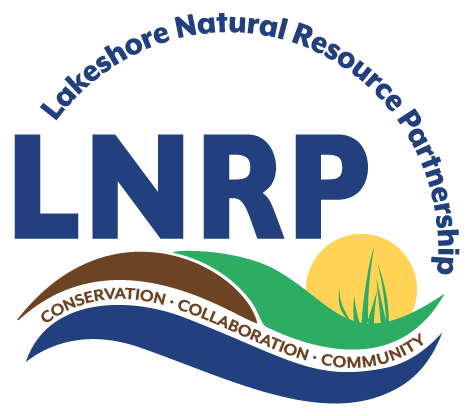Adapting to Change: Collaborative & Science-Driven Reforestation for Coastal Resilience
Fischer Creek tree planting
The Great Lakes region is facing a growing array of challenges from the continual spread of invasive pests to a warming climate that brings with it new extreme weather patterns. These issues are placing unprecedented strain on our coastal habitats, endangering the ecological health of areas critical to migratory birds and other wildlife. Lakeshore Natural Resource Partnership (LNRP) has responded to these challenges with an innovative, collaborative approach that leverages science-driven strategies to ensure the long-term resilience of Lake Michigan coastal ecosystems.
With funding from the U.S. Forest Service and Wildlife Conservation Society, LNRP is working with a team of consultants, nonprofits, municipalities, and community members to spearhead a comprehensive tree planting initiative that tackles these environmental threats head-on. Our project is not just about planting trees—it’s about planting the right trees in the right places, informed by the latest climate vulnerability assessments and habitat suitability models. These models, many developed with tools from the Northern Institute of Applied Climate Science, help us identify the most effective actions to protect and restore the forests and wetlands that line the western shores of Lake Michigan.
A Science-Driven Approach to Building Resilience
Our initiative is grounded in a clear understanding of how climate change and other shocks like invasive species are impacting our region. By selecting tree species that are not only native but also adapted to the future conditions expected in our area, we are ensuring that the forests we restore today will thrive for decades to come. This approach is crucial for both climate adaptation—helping ecosystems adjust to new conditions—and climate mitigation—capturing and storing carbon to reduce the overall impact of climate change.
Note: This map was created in 2022, please see below for a comprehensive list of planting sites.
Another pressing threat to our forests is the Emerald Ash Borer, an invasive beetle that has devastated ash tree populations across the country. By diversifying the tree species we plant, we help ecosystems recover from the Emerald Ash Borer while also reducing the risk that a single pest or disease could wipe out entire sections of forest in the future. This ensures that ecosystems stay more stable over time and continue to sequester carbon through respiration to mitigate climate change.
Strategic Planting for Maximum Impact
Our tree planting efforts are carefully targeted to maximize the ecological benefits across a variety of landscapes. We have prioritized sites that offer the greatest potential for improving water quality and enhancing habitat connectivity, including key wetland and river areas in Door, Kewaunee, Manitowoc, Sheboygan, and Ozaukee counties. These areas are crucial not only for wildlife but also for protecting our shorelines from the increasingly severe weather events associated with climate change.
By restoring forest cover in these high-priority areas, we are creating buffers that help stabilize the landscape, reduce runoff, and support coldwater streams that are particularly vulnerable to warming temperatures. The trees we plant today will provide shade and valuable habitat for migratory birds, ensuring that the Lake Michigan flyway remains a vital corridor for wildlife.
Measurable Progress and Collaborative Success
Peterson Park tree planting
Since 2020, we have planted over 15,700 native trees and shrubs across the region, with plans to add 2,500 more in Door County alone by the end of 2024. In addition to these trees, we have installed 5,864 native plant plugs and restored over 100 acres with native seeds, all while maintaining ongoing invasive species control efforts across hundreds of acres. These achievements are the result of a robust partnership network that includes local municipalities, conservation groups, and volunteers, all working together toward a common goal.
This project’s success is a testament to the power of collaboration. With funding support provided by Stantec Consulting Services, we have secured $1,898,000 in total grant funding for this project from US Forest Service - Great Lakes Restoration Initiative grants and the Wildlife Conservation Society’s Climate Adaptation Fund. These funds have been crucial in expanding our efforts and ensuring that every dollar goes as far as possible in restoring and protecting our coastal ecosystems.
Our project partners’ dedication and expertise have allowed us to achieve significant milestones, and together, we are laying the groundwork for a more resilient future for the Lake Michigan coast.
Project Partners: Climate Change Coalition of Door County, Friends of Peninsula and Newport State Parks, Friends of Crescent Beach, City of Algoma, City of Kewaunee, City of Manitowoc, Woodland Dunes Nature Center and Preserve, Manitowoc County, Village of Cleveland, Friends of Hika Park, Wisconsin Department of Natural Resources, Town of Two Creeks, Sheboygan County, Sheboygan River Basin Partnership, Glacierland RC&D, City of Sheboygan, Maywood Environmental Center, the Ozaukee Washington Land Trust, and Stantec Consulting Services.
Project Sites By County as of August 2024:
Ozaukee County:
Forest Beach Migratory Preserve
Donges Bay
Sheboygan County:
Amsterdam Dunes
North Point Bluff
Pigeon River
Sheboygan Marsh
Esslingen Park
Gerber Lake
Old Plank Road Trailhead
Manitowoc County:
Centerville Creek / Hika Park
Fischer Creek Park
Point Creek Natural Area
Silver Creek Park
Lower Schuette Park
Woodland Dunes
Two Creeks Parkland
Manitowoc Marina Bluff
Walla Hi County Park
Silver Lake Park
Manitowoc River Park
Maribel Caves
Lower Cato Falls
St. Nazianz
Kewaunee County:
Olson Park
Peterson Park
Multiple Parks in City of Kewaunee
Door County:
Peninsula State Park
Newport State Park



